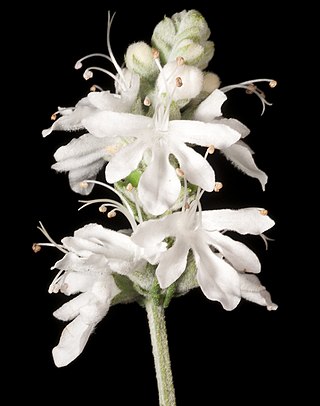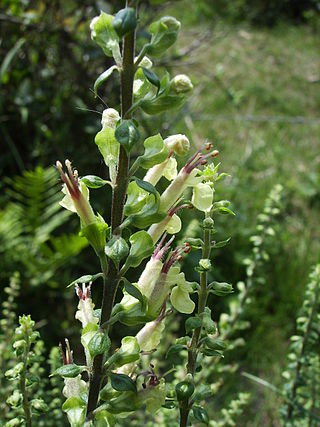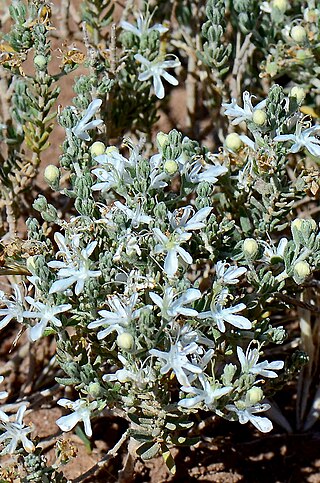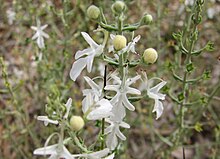
Teucrium is a cosmopolitan genus of flowering plants in the mint family Lamiaceae, commonly known as germanders. Plants in this genus are perennial herbs or shrubs, with branches that are more or less square in cross-section, leaves arranged in opposite pairs, and flowers arranged in thyrses, the corolla with mostly white to cream-coloured, lobed petals.

Teucrium scorodonia, common name the woodland germander or wood sage, is a species of flowering plant in the genus Teucrium of the family Lamiaceae. It is native to Western Europe and Tunisia, but cultivated in many places as an ornamental plant in gardens, and naturalized in several regions.

Teucrium fruticans is a species of flowering plant in the mint family Lamiaceae, native to the western and central Mediterranean. Growing to 1 m (3 ft) tall by 4 m (13 ft) wide, it is a spreading evergreen shrub with arching velvety white shoots, glossy aromatic leaves and pale blue flowers in summer.

Gynodioecy is a rare breeding system that is found in certain flowering plant species in which female and hermaphroditic plants coexist within a population. Gynodioecy is the evolutionary intermediate between hermaphroditism and dioecy.

Teucrium corymbosum, commonly known as forest germander, is a species of flowering plant in the family Lamiaceae and is native to Australia and New Guinea. It is a perennial herb or subshrub densely covered with glands and with narrow egg-shaped leaves usually with toothed edges, and groups of mostly up to ten white flowers.

Symphyotrichum racemosum is a species of flowering plant native to parts of the United States and introduced in Canada. It is known as smooth white oldfield aster and small white aster. It is a perennial, herbaceous plant in the family Asteraceae. It is a late-summer and fall blooming flower.

Teucrium albicaule, commonly known as scurfy germander, is a species of flowering plant in the family Lamiaceae, and is endemic to inland areas of Australia. It is a hoary, perennial herb that spreads by root suckers, forming dense stands. The leaves are trifoliate and the white flowers are arranged singly in leaf axils.

Teucrium argutum, commonly known as native germander, is a species of flowering plant in the family Lamiaceae, and is endemic to eastern Australia. It is a perennial herb often suckering, with hairy, broadly egg-shaped leaves with toothed or wavy edges, and pink-purple flowers.
Teucrium betchei is a species of flowering plant in the family Lamiaceae, and is endemic to eastern Australia. It is a perennial herb or undershrub with rod-like stems, linear to very narrow lance-shaped leaves and white flowers.
Teucrium disjunctum is a species of flowering plant in the family Lamiaceae and is endemic to inland Australia. It is an erect, openly-branched, hairy, greyish-white shrub, usually with egg-shaped to elliptic leaves, and white flowers arranged singly in leaf axils.
Teucrium grandiusculum is a species of flowering plant in the family Lamiaceae and is endemic to central Australia. It is a perennial herb or shrub with toothed, egg-shaped leaves and white flowers.

Teucrium integrifolium, commonly known as teucry weed or green germander, is a species of flowering plant in the family Lamiaceae and is endemic to northern Australia. It is a perennial herb with broadly elliptic to broadly egg-shaped leaves and white or cream-coloured flowers.

Teucrium junceum is a species of flowering plant in the family Lamiaceae, and is endemic to eastern Australia. It is a scrambling, openly-branched shrub, with small leaves, white flowers and orange to red fruit.
Teucrium micranthum is a species of flowering plant in the family Lamiaceae, and is endemic to a restricted area of Queensland. It is an erect subshrub with small, aromatic, egg-shaped to elliptic leaves and small white flowers.
Teucrium myriocladum is a species of flowering plant in the family Lamiaceae and is endemic to the south-west of Western Australia. It is a shrub with small, hairy leaves and creamy-green flowers.
Teucrium pilbaranum is a species of flowering plant in the family Lamiaceae, and is endemic to the Pilbara region of Western Australia. It is an upright subshrub with three-part or deeply-lobed leaves and white flowers.

Teucrium puberulum, commonly known as red berry stick plant, is a species of flowering plant in the family Lamiaceae, and is endemic to inland areas of eastern Australia. It is an erect shrub covered with star-shaped hairs, and with linear to lance-shaped leaves, greenish-white flowers and reddish fruit.
Teucrium reidii is a species of flowering plant in the family Lamiaceae, and is endemic to north-western South Australia. It is a shrub with egg-shaped leaves with blunt teeth on the edges, and white flowers arranged in spike-like groups.
Teucrium sessiliflorum, commonly known as camel bush, is a species of flowering plant in the family Lamiaceae and is endemic to southern continental Australia. It is a tufted perennial herb with hairy, egg-shaped, lobed leaves and white or cream-coloured flowers.

Teucrium teucriiflorum is a species of flowering plant in the family Lamiaceae, and is endemic to arid and semi-arid areas of Australia. It is a semi-scandent shrub with many branches, linear to narrow lance-shaped or narrow egg-shaped leaves and creamy-white flowers.













